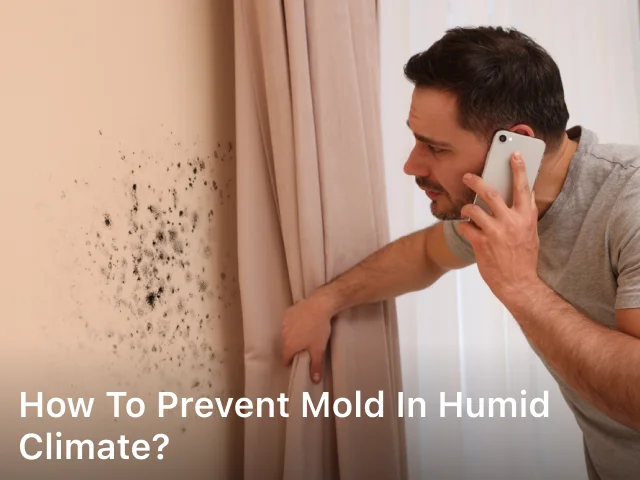
How to Prevent Mold in Humid Climate? Learn effective strategies to prevent mold growth in a humid climate. Our comprehensive guide covers everything you need to know about keeping your space mold-free.
Humidity can be a blessing and a curse, especially if you live in a humid climate. While it’s great for your skin, excessive moisture can lead to a common household problem: mold growth.
Mold not only damages your property but also poses health risks. In this article, we’ll explore effective strategies to prevent mold in a humid climate.
Living in a humid climate can be challenging, as the excess moisture in the air creates the perfect breeding ground for mold. Mold not only damages your property but also poses health risks to you and your family.
However, with the right knowledge and strategies, you can keep mold at bay and enjoy a healthier living environment. In this comprehensive guide, we’ll walk you through the steps to prevent mold growth effectively.
How to Prevent Mold in Humid Climate?
Mold prevention starts with understanding the root causes and taking proactive measures to control them. Here are some key steps to prevent mold in a humid climate:
Understanding Mold Growth
Before diving into prevention methods, it’s essential to understand how mold grows. Mold thrives in damp, dark, and warm conditions. It reproduces through spores that float in the air and settle on surfaces, leading to mold colonies.
Proper Ventilation
One of the most effective ways to prevent mold is to ensure proper ventilation in your home. Use exhaust fans in bathrooms and kitchens to remove excess moisture. Additionally, opening windows on dry days can help circulate fresh air and reduce humidity indoors.
Dehumidifiers
Invest in a high-quality dehumidifier to maintain optimal humidity levels in your home. Keeping humidity below 50% is crucial for mold prevention. Ensure you choose the right size of dehumidifier for your space.
Regular Cleaning and Maintenance
Regularly clean and inspect your home for any signs of moisture or leaks. Address any plumbing issues promptly, as even small leaks can contribute to mold growth. Clean and dry any wet surfaces or materials within 48 hours to prevent mold from taking hold.
Use Mold-Resistant Products
When renovating or building, opt for mold-resistant materials like drywall, paint, and insulation. These products are designed to inhibit mold growth and are especially valuable in humid climates.
Landscaping and Drainage
Ensure that the landscaping around your home encourages proper water drainage. Properly sloping the ground away from your foundation and installing gutter extensions can prevent water from pooling near your home.
Regular HVAC Maintenance
Maintain your heating, ventilation, and air conditioning (HVAC) system regularly. Clean or replace filters, check for leaks, and ensure that the system is functioning optimally. An efficient HVAC system can help control indoor humidity.
Use Mold-Preventing Paints
Consider using mold-preventing paints in areas prone to moisture, such as bathrooms and basements. These paints contain antimicrobial agents that deter mold growth.

What temperature should I keep my house to prevent mold?
Maintaining the right temperature in your home is a crucial step in preventing mold growth. By keeping your indoor temperature within the range of 68°F to 72°F and following additional mold prevention tips, you can create a healthy and comfortable living environment.
Remember that controlling humidity, along with temperature, is key to keeping mold at bay and ensuring the well-being of your home and family.
FAQs
Is mold always visible?
No, mold is not always visible. It can grow behind walls, under flooring, or in hidden corners. That’s why regular inspections are essential for mold prevention.
Can I remove mold on my own?
Small patches of mold can often be removed with household cleaners. However, extensive or recurring mold problems should be handled by professionals.
Are all molds harmful?
While not all molds are harmful, some can produce toxins that pose health risks. It’s best to address any mold growth promptly and take preventive measures.
Can mold affect my health?
Yes, mold can have adverse health effects, especially for individuals with allergies or respiratory conditions. Common symptoms include coughing, sneezing, and respiratory issues.
How often should I check for mold?
Regular inspections for mold should be conducted at least once a year, but more frequent checks are advisable, especially in humid climates.
Does insurance cover mold damage?
Insurance coverage for mold damage varies, so it’s essential to review your policy and consider adding additional coverage if you live in a humid climate.
Conclusion
Living in a humid climate doesn’t mean you have to live with the constant threat of mold. By following the steps outlined in this guide, you can effectively prevent mold growth and maintain a healthy living environment.
Remember that vigilance and proactive measures are key to keeping mold at bay. Enjoy the benefits of your humid climate without the worry of mold by implementing these strategies.




